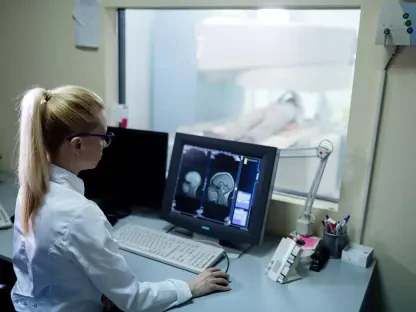The integration of data and artificial intelligence (AI) in healthcare is revolutionizing how surgeries are performed. Gone are the days when manual procedures dominated operating rooms, replaced now by data-driven, AI-enhanced environments that promise improved patient outcomes and operational efficiencies. This article delves into the significant strides made in surgical practices due to technological advancements, highlighting the transformative impact of data and AI.
The Evolution of Surgical Practices
Over the past few decades, surgery rooms have transformed from being heavily reliant on manual processes to adopting sophisticated technologies. In the past, surgeons used traditional mechanical tools, and patient records were often kept as physical documents, leading to inefficiencies and potential errors. Today, the landscape is dramatically different. Advanced medical technology, coupled with electronic health records (EHRs), wearable devices, and data warehouses, has paved the way for a new era in surgical precision and efficiency.
The shift from manual processes to digital records has significantly minimized human errors. With instant access to a patient’s complete medical history, surgeons can make better-informed decisions. This evolution marks a significant step toward a more efficient and reliable healthcare system where patient safety is prioritized. The ability to access real-time data during surgeries provides medical professionals with the information needed to anticipate complications and mitigate risks effectively.
Moreover, the digitization of surgical environments has facilitated better collaboration among healthcare professionals. Surgeons, anesthesiologists, and nurses can share data instantaneously, leading to more coordinated care. The seamless exchange of information ensures that everyone involved in the surgical process is well-informed and on the same page, thus minimizing misunderstandings and errors. This transition from traditional methods to a technologically advanced setup enhances the overall quality and safety of surgical procedures.
The Critical Role of Data
At the core of this transformation in surgical practices is the critical role of data. Modern healthcare generates vast amounts of data from various sources such as EHRs, medical devices, wearable sensors, and administrative systems. Proper analysis and utilization of this data are essential for advancing preventive healthcare and surgical precision. By crunching numbers and identifying patterns, healthcare providers can gain profound insights into patient care and clinical results, which significantly improve surgical outcomes.
Data analytics goes beyond record-keeping; it encompasses predictive modeling and pattern recognition, which are crucial for anticipating potential complications and preparing proactive measures. This data-centric approach to surgery significantly enhances patient outcomes, reducing the risk of complications and ensuring a smoother recovery process. By leveraging big data analytics, healthcare professionals can predict surgical outcomes with greater accuracy, thus tailoring interventions to meet individual patient needs.
Furthermore, the utilization of data in surgery has led to the development of evidence-based practices. Surgeons can now base their decisions on comprehensive data analysis, rather than solely on experience and intuition. This shift toward data-driven decision-making ensures that the most effective surgical techniques are employed, thus maximizing the chances of success. The integration of data into surgical planning and execution represents a significant advancement in medical practice, contributing to better patient care and treatment outcomes.
AI and Machine Learning in Surgery
The infusion of AI and machine learning (ML) into surgical settings has taken predictive analytics and decision-making to new heights. AI algorithms can sift through vast datasets far more quickly than a human ever could, offering real-time insights that assist surgeons during procedures. AI-powered surgical instruments can provide unparalleled precision, reducing the margin for error and increasing the success rate of surgeries. This technological advancement enhances the capabilities of surgeons, allowing for more accurate and effective interventions.
In addition to real-time decision support, AI aids in tailoring therapies to individual patients. ML models can predict how a patient will respond to a particular treatment based on their medical history and genetic makeup. This personalized approach ensures that each patient receives the most effective and least invasive treatment possible, optimizing their chances for a successful outcome. The use of AI-driven diagnostic tools also enables early detection of potential issues, allowing for timely intervention and better patient management.
AI’s role in surgery is not limited to intraoperative support; it also extends to preoperative planning and postoperative care. AI-powered systems can analyze patient data to create detailed surgical plans, predicting potential complications and suggesting the best course of action. Post-surgery, AI can monitor patient recovery, providing alerts for any deviations from the expected healing process. This continuous monitoring ensures that patients receive the necessary attention and care throughout their recovery journey, further enhancing the overall efficacy of surgical interventions.
Integrating Diverse Data Sources
Integrating data from various sources such as robotic surgery systems, wearable devices, and patient records offers a comprehensive view of surgical performance and patient health. This holistic approach is crucial for modern surgical procedures as it allows continuous improvement and more personalized care. The seamless integration of diverse data sources ensures that all relevant information is available at the point of care, enhancing surgical precision and patient outcomes.
One of the standout advantages of data integration is the ability to create a seamless flow of information. Surgeons can access real-time updates and historical data without switching between systems or relying on outdated information. This integration streamlines operations and ensures that all healthcare providers are on the same page, ultimately enhancing patient care. The consolidation of data from various sources also facilitates more accurate and timely decision-making, reducing the risk of errors and improving the overall quality of surgical care.
Moreover, the integration of diverse data sources enables a more comprehensive analysis of surgical performance. By analyzing data from multiple angles, healthcare providers can identify patterns and trends that may not be apparent when examining data in isolation. This multifaceted approach to data analysis allows for a deeper understanding of surgical outcomes, informing continuous improvement efforts and the development of best practices. The integration of diverse data sources represents a significant advancement in surgical care, contributing to better patient outcomes and more efficient healthcare delivery.
Enhancing Operational Efficiency and Cost Savings
Implementing data-driven tools in surgical settings extends beyond clinical outcomes to operational efficiency and cost savings. Optimizing surgical schedules, managing inventory, and allocating resources more effectively can lead to significant financial benefits for healthcare institutions. Data analytics helps administrators identify bottlenecks and optimize workflows, ensuring that every aspect of the surgical process runs smoothly. The efficient use of resources translates into cost savings, enabling healthcare providers to invest in other critical areas.
Reducing waste and improving resource allocation are critical components of this efficiency drive. With precise data on hand, hospitals can minimize unnecessary procedures, reduce patient wait times, and better predict supply needs. These improvements translate into cost savings, allowing healthcare providers to allocate funds to other vital areas. By optimizing the use of surgical equipment and supplies, hospitals can reduce operational costs while maintaining high standards of patient care.
Additionally, data-driven tools facilitate better resource management by providing insights into equipment utilization and maintenance needs. Hospitals can track the usage and performance of surgical instruments, ensuring that they are in optimal condition and available when needed. This proactive approach to resource management reduces downtime and enhances the efficiency of surgical operations. The implementation of data-driven strategies in surgery demonstrates a commitment to continuous improvement and financial sustainability in healthcare.
Real-Time Monitoring for Enhanced Patient Safety
Advanced real-time monitoring systems are a boon for modern surgical procedures. These systems provide continuous feedback during surgeries, enhancing patient safety and improving outcomes. Real-time alerts and monitoring ensure that any potential issues are immediately identified and addressed, which is particularly crucial for complex surgical procedures. The ability to monitor patient vitals and surgical parameters in real time allows for timely interventions, reducing the risk of complications and improving patient outcomes.
Besides improving immediate patient care, real-time monitoring data can be analyzed post-operation to identify areas for improvement. Doctors and surgical teams can review their performance and develop strategies to enhance future procedures, making real-time monitoring a valuable tool for continuous quality improvement. The insights gained from real-time data analysis contribute to the development of best practices, ensuring that surgical teams are equipped with the knowledge and tools to deliver the highest standard of care.
Furthermore, real-time monitoring enhances patient safety by providing a comprehensive view of the patient’s condition throughout the surgical process. The continuous tracking of vital signs and physiological parameters allows for the early detection of anomalies, enabling prompt corrective actions. This proactive approach to patient monitoring ensures that any deviations from the expected surgical course are quickly addressed, minimizing the risk of adverse events. The implementation of real-time monitoring systems represents a significant advancement in surgical safety and efficacy.
Balancing Innovation with Privacy Concerns
The integration of data and artificial intelligence (AI) in healthcare is transforming surgical procedures like never before. Traditional manual methods in operating rooms are now giving way to advanced, data-driven, AI-enhanced technologies. These innovations are setting new standards, promising to improve patient outcomes and boost operational efficiencies. In the past, surgeons relied solely on their skills and experience, but today, they have access to AI tools that offer real-time data analytics, advanced imaging, and predictive insights. AI can assist in making more precise incisions, predicting potential complications, and even customizing surgical plans to suit individual patient needs. The combination of data and AI allows for minimally invasive procedures, reducing recovery times and risks. This article explores the major advances in surgical practices fueled by these technological developments, showcasing how data and AI are revolutionizing the field. Their transformative impact signifies a new era where surgeries are safer, quicker, and more effective, paving the way for an improved healthcare system.









